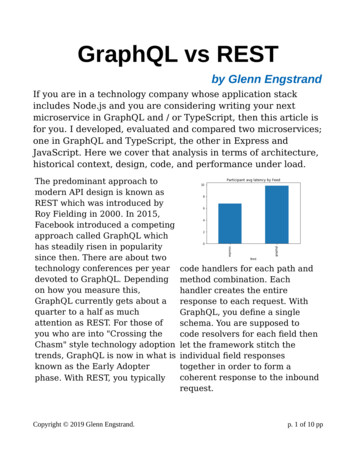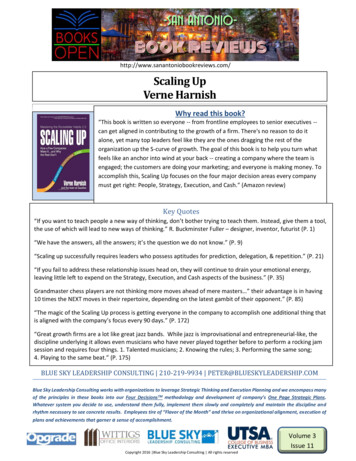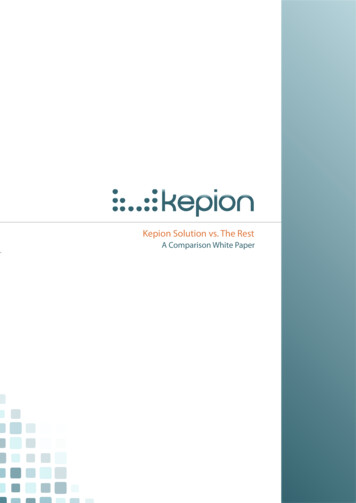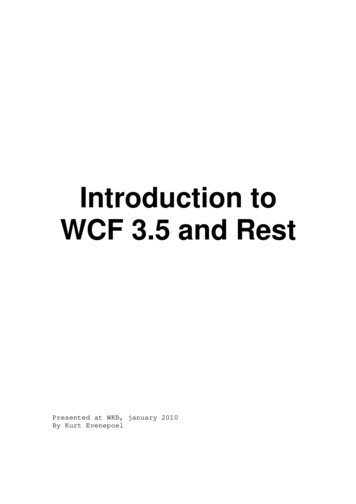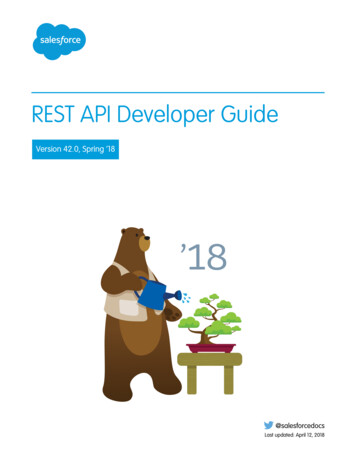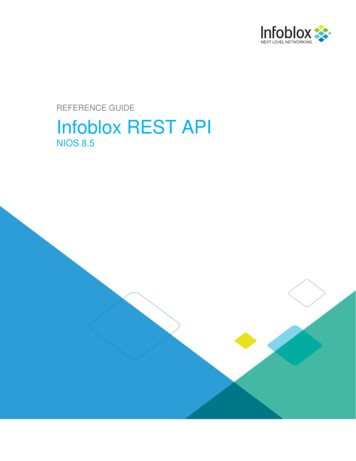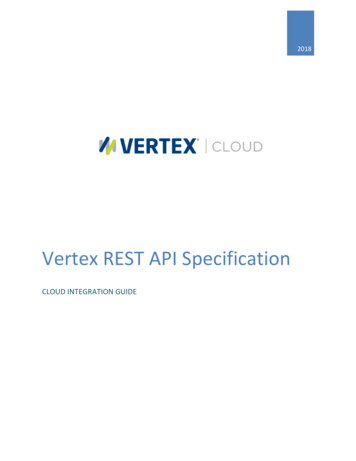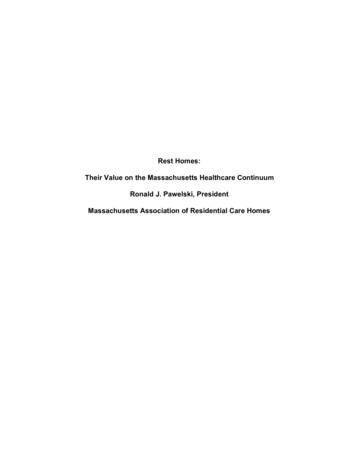
Transcription
Rest Homes:Their Value on the Massachusetts Healthcare ContinuumRonald J. Pawelski, PresidentMassachusetts Association of Residential Care Homes
Rest Homes: Their Value on the Massachusetts Healthcare Continuum1AbstractIn Massachusetts, rest homes provide cost effective care for eldery residents in acommunity setting. Rest homes, however, are not well-understood and the rest homeindustry itself suffers greatly, not only from a lack of understanding of the services theyprovide,but also from the strain on their financial resources due to both competitionfrom other healthcare options and insufficient reimbursement rates for residents’ care.The paper explores the financial challenges facing the industry and outlines the datathat speaks to the value of the rest home care option for both the residents themselvesand Massachusetts state healthcare budget. It compares rest homes with otherinstitutions, including assisted living and nursing homes, and demonstrates thefinancial advantages of rest homes for certain segments of the elderly population. Italso outlines the Massachusetts state government role in funding rest homes, andunderscores the importance that advocacy plays in the industry’s survival. The paperhighlights the issues of rate adequacy, the human impact of closures on elderlyresidents and provides a view of the possible road ahead for this challenged industry.In conclusion, it demonstrates the value of rest homes on the Massachusettshealthcare continuum in medical, financial and social terms.
Rest Homes: Their Value on the Massachusetts Healthcare Continuum2Table of ContentsIntroduction .4Rest Home Industry Profile: An Industry Struggling to Survive .5Rest Home Advocates .6Profile of Rest Home Services .7Discussion Points .9Payment Comparison .11Comparison of Rest Homes to Skilled Nursing Homes .12Rest Home: A Cost-Effective Healthcare Option 13Cost Avoidance Analysis Compared to Nursing Facility Care .16Resident Profile 16State and Federal Agencies Interface: the Need for a Cohesive Program Focus 19Problems with the Lack of Agency Coordination 24Advocacy and Legislative Involvement, including Grassroots Efforts .24Financial Challenges Facing the Rest Home Industry .28
Rest Homes: Their Value on the Massachusetts Healthcare Continuum3The Human Cost of Closures .33The Future of Rest Homes in Massachusetts .34Summary: The Value of Rest Homes .35References .36Appendix .38 IntroductionResidential care homes, licensed as rest homes in Massachusetts, play an importantrole in the care of over four thousand aged, infirm and indigent residents of the
Rest Homes: Their Value on the Massachusetts Healthcare Continuum4Commonwealth. There is a general lack of understanding about who they are, theservices they provide and the population they care for. Often associated with nursinghomes or the rapidly growing assisted living industry, they serve a different populationof the elderly and have significant value over other residential options for elderlypersons. They fill a distinctive and important role on the Massachusetts healthcarecontinuum.Rest homes are also an industry in financial peril. According to the MassachusettsDepartment of Public Health, since 1998, one hundred and two rest homes in the statehave closed, primarily due to financial reasons The financial issues are a direct resultof United States federal and Massachusetts state regulatory compliance requirements,increased costs related to an ever-increasing aging-in-place population and thelightning rod issue of rate adequacy. As a result, over 4,000 residents of closedfacilities were displaced and subjected to the trauma associated with involuntarytransferRest Home Industry Profile: An industry Struggling to SurviveRest homes in Massachusetts have been in existence since the 1800’s. Historicallyoften known as boarding homes or houses, modern day homes were first licensed bythe Massachusetts Department of Public Health in the 1940’s. In the 1970’s, theCommonwealth saw an increase in the number of rest homes as wood framedstructured nursing homes, known as Level III homes, converted to rest homes due to
Rest Homes: Their Value on the Massachusetts Healthcare Continuum5Life Safety Code Compliance issues and to avoid the costs of retrofitting sprinklersystems.At its zenith, the rest home industry had a community presence across theCommonwealth with over 200 homes caring for more than 7,000 aged, infirm andindigent residents. Worcester, Fitchburg and Boston had the highest concentration ofhomes. However, since 1998, one hundred and two homes have closed, due primarilyto financial problems, and more closures are looming.Today, there are only seventy-two rest homes remaining in the Commonwealth. Thesehomes are termed “Free Standing” as they are not part of a nursing facility wing.The average home size is thirty-three beds, with the largest home having eighty-ninebeds and the smallest home, five beds. Forty-nine homes are for-profit with eight of theforty-nine listed as private (not admitting publicly assisted residents). Eighteen homesare listed as not-for-profit, and five homes are listed as religious order homes that donot require licensing by the Department of Public Health. Worcester remains the areawith the highest concentration of rest homes in Massachusetts.Rest Home AdvocatesRest homes in Massachusetts are represented by two primary associations, theMassachusetts Association of Residential Care Homes (MARCH) representing thefor-profit, not-for-profit and religious order homes; and Leading Age of Massachusetts(LeadingAgeMA) representing the not-for profit and selected religious order homes.
Rest Homes: Their Value on the Massachusetts Healthcare Continuum6MARCH is a Massachusetts-based organization formed in 1991. It focuses exclusivelyon advocating and educating on behalf of rest homes in the Commonwealth; theirowners/executive directors, their residents and their healthcare staff. As stated on theirwebsite, www.maresidentialcarehomes.org , its mission is to provide the public with keyinformation about the value of rest homes as an elder care option and to work toenhance the financial viability of the industry.Rest homes provide a cost-effective quality of care for their residents and their familiesin a community-based home-like environment. Legislative and advocacy efforts focuson ensuring that there are no further rest home closures due to financial reasons.LeadingAge Massachusetts, https://www.leadingagema.org , represents the fullcontinuum of not-for-profit providers of healthcare, housing and services for olderpersons in Massachusetts. Their members provide housing and services to over 30,000older adults and persons with disabilities in the Commonwealth. In addition to resthomes, they represent continuing care retirement communities, skilled nursing facilities,assisted living residences, senior housing, home health services, and adult day healthand hospice programs.LeadingAgeMA lists its mission as “ Expand the World of Possibilities for Aging” byleading in innovative practices that transform how we care for the aging population andlead initiatives to develop services that meet “older adult” needs” .Profile of Rest Home Services
Rest Homes: Their Value on the Massachusetts Healthcare Continuum7Rest homes provide medical management, medication management, addresspsycho/social needs in addition to room and board for an average cost of 97.00 perday.(Note: See the MARCH Residential Care Fact Sheet: Provided Services, Appendix,Exhibit 1.)Table 1Comparison of Rest Home Services to Assisted Living Services(Seaman, Kathy, Executive DIrector, Mount Pleasant Home, Jamaica PlainMassachusetts)RESIDENTIAL CARESKILLED NURSING(rest home)(nursing home)Regulated by MAExecutive Office ofElder AffairsLicensed & Regulated bythe MA Department ofPublic HealthLicensed & Regulated bythe MA Department ofPublic HealthProvide up to 3 mealsdaily in dining room &social activitiesProvide 3 meals daily,snacks, social activities &eventsProvide 3 meals daily,snacks, activitiesHousekeeping &laundry services (mayrequire an extra fee)Housekeeping & laundryincludedHousekeeping & laundryincludedOffer 24-hour security24-hour supervision &security24-hour skilled nursing, IVdrugs, oxygen, injections,mechanical lift transfersASSISTED LIVING
Rest Homes: Their Value on the Massachusetts Healthcare Continuum8Onsite staff respondsto emergencies call911Onsite staff respond toemergencies; gives first aid& calls 911Onsite staff responds toemergenciesMay provide oversightof a resident’sself-administration ofmedication (extra fee)Administers medications;maintains medical record,takes MD orders;coordinates medical careneedsAdministers medications;maintains medical record,takes MD orders;coordinates medical careneeds.Supervision ofbathing/dressing for aset number of hours.Additional hours byfee.Provides assistance withbathing dressingAssistance with all personalcare needs; total careLicensed nurse available atMinor nursing servicestimesResident providesfurniturePrimarily private paywith limited statefundingRN & LPN coverage 24/7;medical director availablefor consultationEncourage personalbelongings; furnitureprovidedFurniture provided; mayhave special units for rehab,dementia etc.Mostly subsidized by DTA,SSA, SSI & Pension andMedicare, Medicaid, longterm care insurance &private payLimited private payDiscussion PointsFrom a provided services standpoint, the key difference between assisted living centersand rest homes is the amount of direct care that they provide. Although rest homes arenot required to have licensed nursing and aide staff at their facilities, (the DPH
Rest Homes: Their Value on the Massachusetts Healthcare Continuum9regulation calls for a responsible person and nursing consulting) most rest homes todayhave licensed nursing staff providing direct care.Current Massachusetts assisted living regulations do not permit direct care staff to beemployed on-site. Residents of assisted living centers may contract for services througha private agency for additional care. Given the provided care considerations, rest homesare able to provide care to residents with a higher acuity level, providing more supportwith Activities of Daily Living (ADL); including bathing, feeding, dressing, and grooming.This care differential is a competitive advantage for rest homes.In recent years, per discussions with rest home owners and executive directors, resthomes have received placement referrals from assisted living centers for their residentswho have experienced increased acuity levels and/or have experienced multiple falls.Several assisted living locations have established criteria related to falls prevention andthe ability to ambulate to ensure resident safety and the appropriateness of the residentremaining in an assisted living facility.Assisted living centers generally provide their residents with several apartment modelsto select from. Rest homes, many of which are old Victorian-style mansions updated tocomply with state requirements, provide single, double and in some casesfour-to-a-room living options.As assisted living centers are decidedly newer construction, (as opposed to rest homesmost of which were built prior to 1978), they have a clear competitive advantage in their
Rest Homes: Their Value on the Massachusetts Healthcare Continuum10choice of living arrangements. Their new construction, coupled with the option not toshare living space, poses a significant threat to the continued existence of rest homes.If assisted living centers are permitted to have licensed nursing staff on site, it will signalthe end of the rest home industry. Recently, the Somerville Home in Somerville,Massachusetts, decided to cease operations due to the opening of a new assisted livingcenter in the area. The rest home’s board of directors carefully reviewed the financialimplications and realized that the Somerville home would not be able to compete as arest home and made the difficult decision to close. Approximately fifty residents of theSomerville home were sent to different healthcare institutions and were subjected to thetrauma of involuntary transfer.Payment ComparisonResidents of assisted living centers predominantly pay privately. There are fewsubsidies available to their residents at this time. Once the residents exhaust theirfunds, they may find that they need to make alternative living arrangements.Residents of rest homes either pay privately or receive payment for their care from theMassachusetts Department of Transitional Assistance nsitional-assistance-regulationsEach rest home has its own specific rate as established by the Commonwealth. Forthose residents receiving Social Security, Supplemental Security Income (SSI) or apension, the rest home applies that monthly amount minus 72.80 and uses the
Rest Homes: Their Value on the Massachusetts Healthcare Continuum11MassHealth claims payment system to bill the Commonwealth for the balance of themonthly bill. For those residents that have no income and qualify Emergency Aid to theElderly, Disabled and Children (EAEDC), DTA will pay the members or the rest homedirectly for the resident’s care.Comparison of Rest Homes to Skilled Nursing HomesFrom a care standpoint, the primary difference between a rest home and a nursinghome is the amount and level of complexity of the care provided. Nursing facilities nowprovide an extensive range of services that include skilled nursing care, rehabilitationservices; including physical therapy, occupational therapy and speech therapy anddementia care including Alzheimer’s. Nursing facilities are equipped to care forresidents with higher acuity levels, residents who are non-ambulatory and/or residentswho are there for rehabilitation stays.Per the Long-Term Care in Massachusetts Fact Sheet: (2008) Of those residents covered by MassHealth, 46% stay less than a year, 33% oneto four years, and 21% more than four years. The average length of stay for MassHealth beneficiaries is 2.4 years. Note thatthese figures do not count the time the beneficiary may have spent in the facilityprior to qualifying for MassHealth.From a living arrangement standpoint, the model is institutionally - based with residentshaving the option of private or semi-private rooms.
Rest Homes: Their Value on the Massachusetts Healthcare Continuum12Rest homes provide medical management in a community setting. Many of thesehomes are actively engaged in the community and their residents are active membersof the community. Rest home residents typically do not require the higher level of carefound in nursing homes. The acuity levels of rest home residents as high, although thisis beginning to change based on an ever-increasing aging-in-place population. Mostresidents are ambulatory, although a small percentage are ambulatory with assistanceof a cane or a walker. Complex medical services, if provided, are contracted services.Residents in rest homes have a much longer length of stay as these places become theresidents’ home . While no exact data exist regarding length of stay, anecdotalinformation presented by owners and executive directors notes that the vast majority ofthe residents have been in their homes for decades. Residents generally remain in theirrest home until they require more care than the rest home can provide or until they die.Rest Homes: A Cost-Effective Health Care OptionIn Massachusetts, statewide averages for nursing homes costs totaled 327 per day fora semi-private and 350/day for private totaling over 127,000 per year. Assisted livingaveraged 4,645 per month or 55,740 per year while providing fewer services than anursing home. Note: Per Mass Senior Care for SFY 2019, the MassHealth average perdiem payment rate is 212 per day or 77,380 per husetts/cost-for-massachusetts-nursing-homes.htm
Rest Homes: Their Value on the Massachusetts Healthcare Continuum13Table 2Comparing Long Term Care in MassachusettsEstimated Annual Cost (median rates) 128k 64k 57k 54k 37k 17kNursingAssistedHomeHomeRestAdult DayHomeLivingHealthmakerHomeCareAideNon-MedNursing Home data is based on a Semi-Private Room.
Rest Homes: Their Value on the Massachusetts Healthcare Continuum14The nursing home trade association, Massachusetts Senior Care, makes the case thatthe MassHealth reimbursement rates on average trail actual costs by 37 per day perpatient.Here are a few figures about overall MassHealth nursing home payments:(Long-Term Care in Massachusetts Factsheet ) In 2007, nursing facilities earned 3.7 billion, of which 70% was covered byMassHealth, 14% by Medicare, and 16% out-of-pocket or other payers. Use of nursing homes has declined significantly in recent years, from more than50,000 residents in 1995 to approximately 45,000 today. In 2003, 73% of MassHealth's long-term care expenditures went to nursingfacilities; by 2008, this had dropped to 60%.Compared to the other care options listed about, Rest Homes represent a cost-effectivecare option based on the following: The average cost of a one-year stay to the Commonwealth is 37,000 perresident, assuming the member is completely dependent on state funding fromthe Department of Transitional Assistance. Approximately 50% of rest home residents have some form of Social Security,SSI or retirement income, meaning that the expenditure to the Commonwealthwould be less than 37,000 per resident per year.
Rest Homes: Their Value on the Massachusetts Healthcare Continuum15 The annual expenditure for rest home care under DTA is approximately 50million annually. There is no federal financial participation or match as resthomes are not considered Medicaid providers. The per diem cost includes medical management, medication management,psycho-social support AND room and board. Occupancy rates have remained over 90% for most rest homes, due in large partto the number of closures.Cost Avoidance Analysis Compared to Nursing Facility CareIf the rest home industry did not exist and the majority of the current resident populationwere placed in nursing homes, the Commonwealth would be facing an incrementalcharge to MassHealth of 35 million per year. This assume 50% federal matchingfunds. If no additional funding comes from the federal government, the figure would beeven higher; approximately 70 million per year.The “ballpark” analysis is as follows:2000 residents (estimated) X ( 212.00 – ( 97.00) daily rate X 365 70,809,788 peryear.In summary, rest homes represent over a 35 million per year cost avoidance to theCommonwealth.Resident Profile
Rest Homes: Their Value on the Massachusetts Healthcare Continuum16To best understand who resides in rest homes, I relied on the following two approaches:The first approach references the survey work completed by Mary Bronski,Characteristics and Demographics of Residential Care Facility Residents inMassachusetts. Dr. Bronski profiled the residents of Massachusetts residential carehomes through the completion of a web-based survey of rest home owners andadministrators. The study was groundbreaking as it was the first time that ademographic study was completed of rest home residents.Here are key characteristics and demographics of the population surveyed: Age: Over 75% of the population is 65 or older with over 34% greater than 85years of age. While this points to an aging-in-place population, it was surprisingto learn that close to 8% of the population was between
the end of the rest home industry. Recently, the Somerville Home in Somerville, Massachusetts, decided to cease operations due to the opening of a new assisted living center in the area. The rest home’s board of directors carefully reviewed the financial implications and realized that the S





